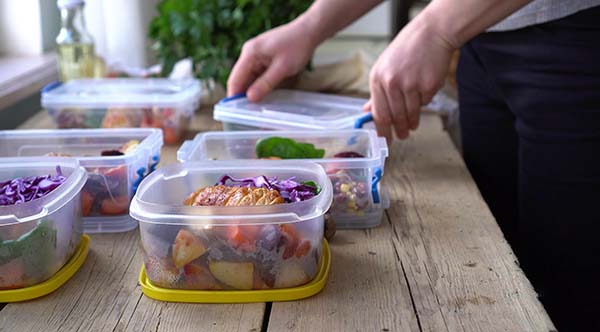Blog
Nutrition Series: Meal Planning & Prep, Part 1
Learn the importance and how-to's of meal planning.
Meal planning, prep, and grocery shopping are the make-it or break-it side of reaching fitness and health goals. Working out is important but it’s only a fraction of the equation. Long-term success will require making consistent changes to current shopping and eating habits. Time to put all of our basic nutrition to work where the “rubber meets the road” and talk about meal planning.
I am not talking about “going on a diet” because that implies it is temporary. Going “on” means you will “come off” at some point. What I’m talking about is deciding on making healthy eating and meal planning a lifestyle.

Meal planning and prep will not only save you time, but also money, reduce food waste, and help alleviate stress when meal times come around, especially after a hectic day at work or school. We have the best intentions when it comes to eating healthy. We get inspired or excited by someone or something we see, we make New Year’s resolutions, etc., but following through is where dedication and planning prevail. What it boils down to is YOUR motivation and system in place; what makes you want to dedicate time, money, and sacrifice to make your healthy diet a lifestyle? Sure, we all want to look our best and feel great, have energy, etc. but what else is driving you? I can tell you first hand, there are some days after my toddlers go to bed I just want to sit on the couch, eat cereal, watch a few shows and go to bed early; and honestly, that’s happened a few times. But the next day, it’s back to the grind, back to the system. For me, it’s my boys, proving to myself and my boys that taking care of my health for them and myself is worth the time, the planning, the effort.
Other than wanting to reach your appearance, fitness, or weight goals, what are other motivations for meal planning and prepping?
Why is being fit and healthy a priority? Is it for you or for someone else? Is it because someone told you to make changes, or are you deciding for yourself?
Have more time with your family?
Save money on your food budget?
Want to learn new cooking skills?
Common schedules for meal plans are for one or two weeks, or a one-month plan if you like! I prefer a month’s plan because I like routine, I like knowing how long recipes will take to prepare, and knowing what to buy at the grocery store consistently. I don't mind repetition in meals, so it is simply a matter of re-stocking when I go to the grocery store each week.
A day-to-day approach is not recommended unless you have incredible discipline, a pretty large budget, hours of free time to cook, or you enjoy feeling like one of the chef contestants on “Chopped”.
There are pros and cons to the different meal schedules, so let’s consider a few to help you decide what is best.
A one-week rotation:
Pros:
A one-week meal plan/prep is a good place to start to get your feet wet with time management and gauge your kitchen savvy.
One/two-week is a relatively short time period and easier to adhere to if you are just starting out.
One/two-week allows flexibility in incorporating sales and seasonal produce into your meal plan.
Cons:
One-week will pass quickly, so you will need to have a new plan ready to go by the weekend for the following week if you want to make changes.
One-week is really not long enough to get the full benefits or sense of following a fully planned and executed meal plan.
If there were extenuating circumstances that week, it would not give you a good gauge of what meal prep/planning would be like “normally”.
A one-month rotation:
Pros:
Provides you with 4 weeks of planned meals and gives a long buffer before having to think about “what am I going to eat today?”
Allows you to see consistent costs for foods/recipes you want to eat, or where you need to cut back if you are staying within a tighter budget.
Will be more effective in showing weight loss efforts since you have a month of consistent intakes.
Cons:
Will likely have repetition in meals/ingredients.
Does not allow for much change in the routine unless you are very cooking/creative savvy.
An easier place to start can be changing your beverage choices. Cutting out or significantly reducing soda, alcohol, and sweetened beverages is a great start. Those calories can quickly add up and removing them from your daily intakes and replacing them with water or unsweetened alternatives will automatically help you start shedding unwanted pounds.
Since we have to eat to live, food can either be the fuel to our success, or the saboteur to our goals.
A well-balanced meal plan will provide you with parts of all 5 food groups (as mentioned in our first article) and keep things healthy and interesting.
Another consideration for meal planning is your environment:
Are you driving in the car most of the day?
Do you travel through airports often?
Do you work from home or the office?
How often do you need to take food with you outside of the home?
Storage and food safety will come into play depending on your environment and schedule. A small food cooler with cold packs makes a great and necessary companion to anyone wanting to take control of their diet. Also, having access to a microwave, fridge/freezer, etc. are considerations when planning what types of foods to plan and prep for your meal plan. It would not make sense to bring frozen food somewhere that does not have the ability to reheat your food (microwave/stove).
Food safety is easy to overlook or to be a second thought for many home chefs, however, paying attention to proper storage and cooking temperatures as well as hand and utensil sanitation is important to prevent recurrent food poisoning, especially when making food in large quantities. If you are not going to be eating all of the food within the time you are at your destination, you need to be able to keep it properly cooled (below 40*F) until it is time to eat.
Cooked meats and poultry should be eaten within 3-4 days of being cooked, and all leftovers are recommended to be reheated to an internal temperature of 165 degrees to prevent foodborne illness.
A few other food safety recommendations:
Wash your hands before starting for at least 20 seconds (and after they are soiled by raw meats before touching your fresh produce).
Clean and sanitize your countertops/cooking surfaces before getting started.
Replace plastic or wood cutting boards with deep cracks, chips, or missing chunks.
Use separate cutting boards for fruits and veggies than you do for raw proteins.
Change out your hand towels often, wash and replace…please don’t air dry the same towels for days.
Lastly, a consideration you may have is the season. Eating foods that are growing in season will cut down on cost and help create a little variety in your diet throughout the year.
I would also take an inventory of the shelf-stable foods you have in your pantry (rice, rolled oats, dried beans, pasta, canned tuna, canned tomatoes et.) or freezer. Certain items you do not typically have to buy on a weekly basis. However, some of you more hard-core weight lifters may be buying rice and rolled oats every week, #gains.
Whatever your rotation preference, it will serve you well to plan ahead and stay consistent.
Part 2 will be going through setting up your schedule, time management with prepping and cooking, as well as how to pair different foods. Stay tuned!

About the author Jessie Gall, MS, RD, LD
Jess is a Metro-Atlanta-based dietitian in the state of Georgia with 8 years of experience as a Registered Dietitian in the hospital setting, as well as corporate wellness events, and individual counseling. She received her Bachelor of Science and Master of Science from Georgia State University and is a Licensed and Registered Dietitian Nutritionist.
Jess enjoys helping her patients have the “lightbulb moments” in their nutrition care and recommendations. Her “food philosophy” is that food is functional and fun! Eating for health does not have to be boring or tasteless. All things in moderation make for a more enjoyable, and healthy relationship with food. There is no one-size-fits-all approach to nutrition, but there are research-based recommendations, and she enjoys helping each patient/client find what works for their lifestyle, goals, and needs. Jess is also an NPC Bikini division competitor, NASM Certified Nutrition Coach, and mother of twin boys.
Instagram @Jess_G_Fit
